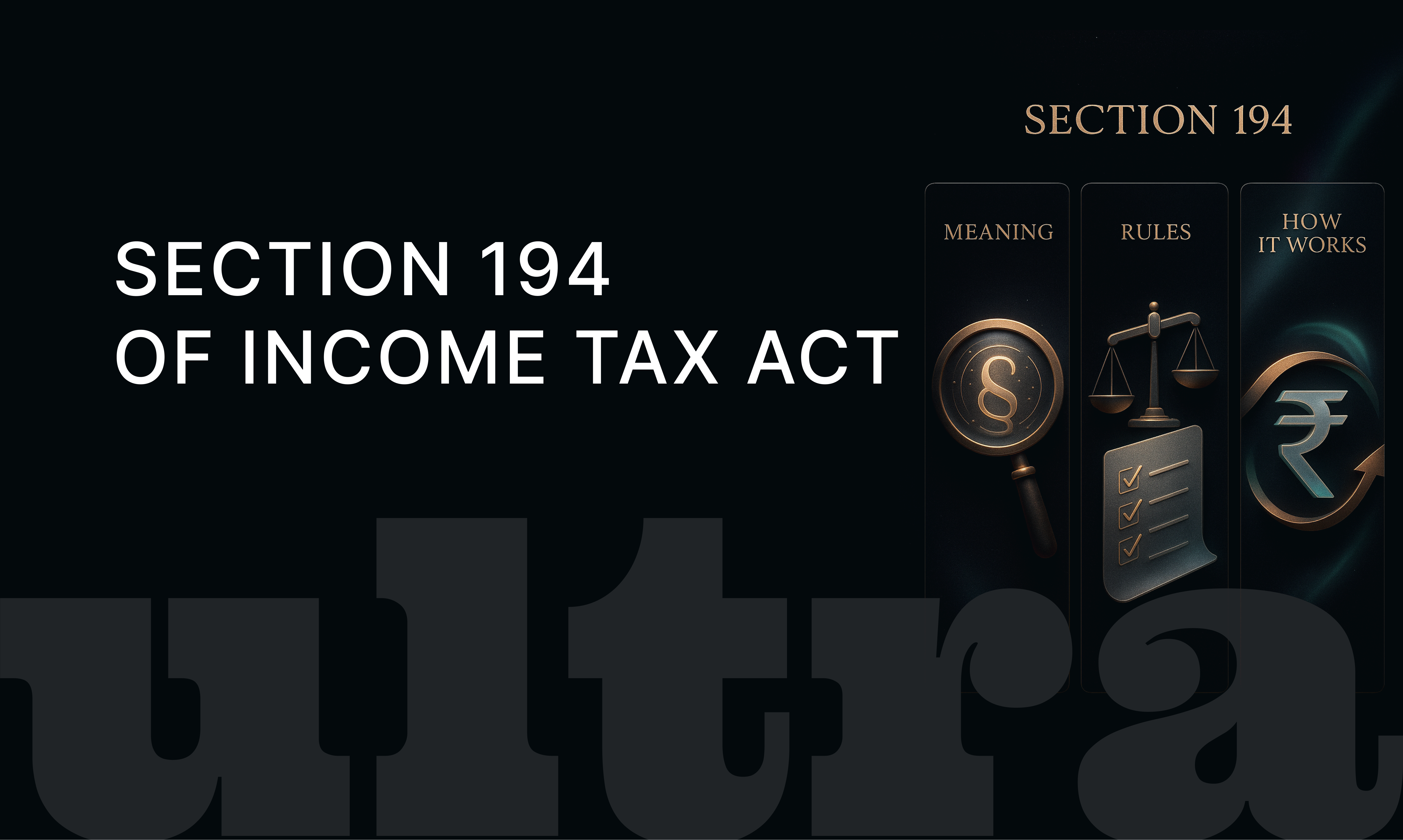Section 194 of Income Tax Act: Meaning, Rules and How It Works
16 July 2025 · Sachin Gadekar
Know How Section 194 TDS Works and What Section 194A Covers

What is Section 194 of Income Tax Act?
Tax Deducted at Source (TDS) is an important concept in the Indian Income Tax system. Among various TDS sections, Section 194 of the Income Tax Act holds significant importance. In this guide by Ultra, we break down what Section 194 covers, its applicability, rates, and how it connects to Section 194A and other related provisions.
Section 194 of Income Tax Act deals with TDS deduction on payments made by certain persons. In simple words, whenever specific payments are made that are covered under this section, the payer is required to deduct tax at source before paying the remaining amount to the payee.
The core idea behind Section 194 is to collect tax at the very source of income generation, ensuring a steady flow of revenue to the government and promoting tax compliance.
Understanding Section 194 TDS
TDS under Section 194 is generally applicable on payments such as dividends and other specified payments by Indian companies to resident shareholders. Over time, the original Section 194 has branched out into sub-sections covering various payments.
Key highlights:
TDS under Section 194 applies mainly on dividends paid by domestic companies to resident shareholders.
The payer (company) must deduct TDS at the applicable rate before making payment.
If the dividend amount paid to a shareholder exceeds Rs. 5,000 in a financial year, TDS must be deducted.
The standard TDS rate under Section 194 is 10% (subject to valid PAN submission).
What is Section 194A of Income Tax Act?
While Section 194 covers dividend payments, Section 194A specifically deals with TDS on interest other than interest on securities.
Section 194A highlights:
It mandates TDS on interest payments by banks, co-operative societies, post offices, and other institutions.
For individuals or HUFs who are not required to audit their books, Section 194A does not apply.
TDS is applicable if the interest payment exceeds certain limits:
₹40,000 per year (₹50,000 for senior citizens) for interest from banks and post office deposits.
TDS under Section 194A is deducted at 10% (with valid PAN).
Section 194 vs Section 194A: Key Difference
| Aspect | Section 194 | Section 194A |
|---|---|---|
| Applies To | Dividend payments by domestic companies | Interest other than interest on securities |
| Who Pays | Companies paying dividends | Banks, post offices, NBFCs paying interest |
| Threshold Limit | ₹5,000 per year | ₹40,000 (₹50,000 for seniors) |
| TDS Rate | 10% | 10% |
| Section PDF | Can be referred to in Income Tax Act PDF | Covered under the same Act |
Exemptions under Section 194 & 194A
If the total dividend or interest income is within the threshold limit, TDS is not deducted.
If the payee submits Form 15G or Form 15H, and the income is below the taxable limit, no TDS will be deducted.
Certain institutions like LIC, UTI, and specific notified companies are exempt from TDS under Section 194A.
How to Avoid Excess TDS under Section 194
To avoid excess TDS deduction:
Keep your PAN updated with banks and companies.
Submit Form 15G (for individuals below 60 years) or Form 15H (for senior citizens) if your total income is below the taxable limit.
Track your dividend and interest incomes regularly.
Example: How TDS under Section 194 Works
Example: If you hold shares of an Indian company and it declares a dividend of ₹10,000 in a year: Dividend up to ₹5,000: No TDS. Dividend beyond ₹5,000: TDS at 10% on the remaining ₹5,000. So, ₹500 will be deducted as TDS and you’ll get ₹9,500.
Example: How TDS under Section 194A Works
Example: You have a fixed deposit earning annual interest of ₹50,000. If you are below 60 years, and the total interest exceeds ₹40,000: TDS @10% will apply on ₹10,000 (₹50,000 – ₹40,000). So, ₹1,000 will be deducted as TDS. Senior citizens have a higher limit of ₹50,000.
Why TDS under Section 194 is Important
Helps government collect tax at the source.
Reduces the burden of lump-sum tax payment at year-end.
Ensures transparency in income reporting.
Encourages better tax compliance.
FAQs on Section 194 of Income Tax Act
Q1. What is Section 194 of Income Tax Act?
Section 194 deals with TDS on dividends paid by domestic companies to resident shareholders.
Q2. What is Section 194A of Income Tax Act?
Section 194A mandates TDS on interest other than interest on securities — like FD, RD, or savings interest from banks and post offices.
Q3. What is the TDS limit under Section 194?
TDS is applicable if the dividend paid exceeds ₹5,000 in a year.
Q4. How much TDS is deducted under Section 194A?
The TDS rate is 10% if total interest exceeds ₹40,000 for regular citizens and ₹50,000 for senior citizens.
Q5. Can I avoid TDS under Section 194A?
Yes, by submitting Form 15G/15H if your total income is below taxable limit.